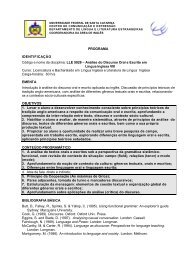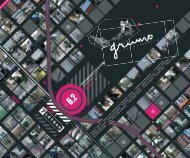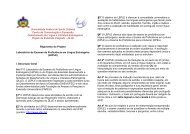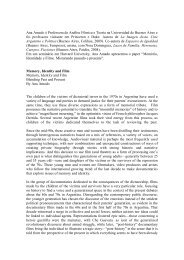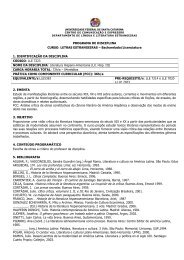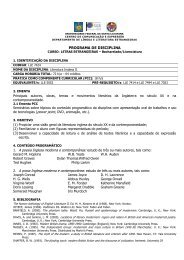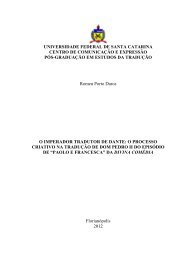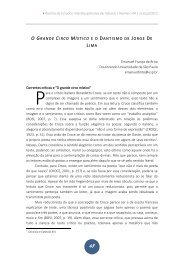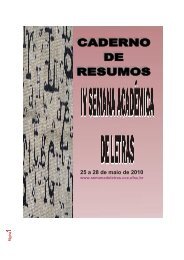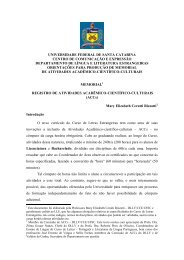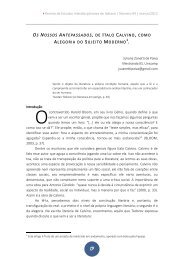Mesas-Redondas 2011 - Semana de Letras - UFSC
Mesas-Redondas 2011 - Semana de Letras - UFSC
Mesas-Redondas 2011 - Semana de Letras - UFSC
You also want an ePaper? Increase the reach of your titles
YUMPU automatically turns print PDFs into web optimized ePapers that Google loves.
Página17<br />
Synchronous and asynchronous online activities and the <strong>de</strong>velopment of L2 speakingskills<br />
MARCELO MARTINS KREMER E FERNANDA RAMOS MACHADO<br />
The two activities selected to be presented were the ones that are more frequently used in thecourseentitled<br />
Compreensão e Produção Oral em Língua Inglesa IV, whichintegratesthe curriculum oftheprogram Licenciatura em<br />
<strong>Letras</strong>-Inglês na Modalida<strong>de</strong> a Distância. These activities are the basis of the gra<strong>de</strong>d online activities that occur<br />
during the entire semester. The first one is entitled “Skype Chat”, which allows participants to have a real-time<br />
synchronous discussion via the web on a weekly basis. Every Skype Chat may have 5 stu<strong>de</strong>nts at maximum, plus the<br />
Tutor, and each session lasts for 30 minutes. Every week the Skype Chat is scheduled on the online forum of the<br />
discipline by the Tutor and the stu<strong>de</strong>nts. The second type of activity is entitled “Final Project – Audio File”, which can<br />
be done in two ways. The first option is to use the NanoGong recor<strong>de</strong>r, which provi<strong>de</strong>s a very simple and transparent<br />
voice recor<strong>de</strong>r support for Moodle. It can be used to record, playback and save a voice file, in a web page. A<br />
NanoGong activity allows the stu<strong>de</strong>nt to submit a voice recording file to the teacher. The second option is to submit<br />
an audio file (.mp3, wva, etc) recor<strong>de</strong>d with any digital recording <strong>de</strong>vice. Both the Skype Chat and the Final Project –<br />
Audio File activities give the stu<strong>de</strong>nts a chance to talk about a topic discussed in the lessons using the target<br />
functions and grammatical structure. Keywords: L2 speaking, online tools, synchronous/asynchronous activities<br />
The role of face-to-face tutors in a blen<strong>de</strong>d distance learning course<br />
DANIELLE AMANDA RAIMUNDO DA SILVA<br />
Technology has <strong>de</strong>cisively influenced and brought to bear new ways of learning. By using a variety of tools, it is<br />
possible to interact without getting together physically, which makes feasible, for example, to have stu<strong>de</strong>nts from<br />
different cities in the same classroom in an online environment. This is the main feature of distance education;<br />
however, some distance courses are based on a blen<strong>de</strong>d format, recognizing that a face– to-face component has its<br />
place in the learning process. In the discipline Compreensão e Produção Oral em Língua Inglesa ofthe <strong>Letras</strong>-Inglês<br />
na Modalida<strong>de</strong> a Distância Program (<strong>UFSC</strong>/UAB), the face-to-face tutors are seen as mediators of a number of<br />
synchronous activities (Tractenberg, 2008) that take place on campus, and which are planned by the instructor in<br />
charge of organizing the course. Aiming to better un<strong>de</strong>rstand the role played by the face-to-face interaction<br />
component in the discipline, the present work takes into account the impressions of face-to-face tutors about the<br />
<strong>de</strong>velopment and outcomes of activities taking place on the different campuses. In an attempt of gathering an<br />
authentic report from the tutors concerning their beliefs and experiences, it was administered a questionnaire ma<strong>de</strong><br />
of open-en<strong>de</strong>d questions. Keywords: blen<strong>de</strong>d course, tutors, L2 oral skills<br />
Planning, recording and using tailor-ma<strong>de</strong> vi<strong>de</strong>o lessons to teach oral skills online<br />
ROSANE SILVEIRA<br />
In second language courses, both in face-to-face and in distance learning programs, vi<strong>de</strong>o-based activities play a<br />
central role (Canning-Wilson, 2000; Brooke, 2003). In the discipline Compreensão e Produção Oral em Língua Inglesa<br />
ofthe <strong>Letras</strong>-Inglês na Modalida<strong>de</strong> a Distância Program (<strong>UFSC</strong>/UAB), vi<strong>de</strong>o lessons are frequently used to enhance<br />
learners’ listening and speaking skills. Although the instructors and the online tutoring team select many vi<strong>de</strong>o<br />
activities available online, we also make an effort to put together some vi<strong>de</strong>o-lessons that are tailor-ma<strong>de</strong> to our<br />
stu<strong>de</strong>nts. The purpose of this presentation is twofold. First, I explain how these vi<strong>de</strong>o lessons are planned and<br />
recor<strong>de</strong>d, which inclu<strong>de</strong>s information about the participation of the tutoring team and other guests, and the role of<br />
the technical team in charge of recording and editing the vi<strong>de</strong>os. The second purpose is to explain how these vi<strong>de</strong>o<br />
lessons are integrated to the online lessons and how stu<strong>de</strong>nts react to this type of activity.<br />
Keywords: vi<strong>de</strong>o lessons, L2 oral skills, online



